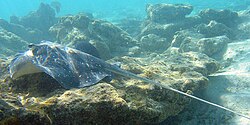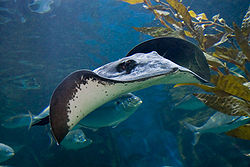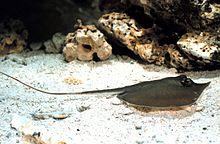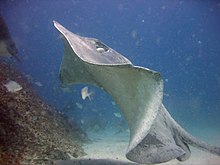This is an old revision of this page, as edited by 167.93.22.50 (talk) at 15:15, 11 February 2008 (→Feeding habits). The present address (URL) is a permanent link to this revision, which may differ significantly from the current revision.
Revision as of 15:15, 11 February 2008 by 167.93.22.50 (talk) (→Feeding habits)(diff) ← Previous revision | Latest revision (diff) | Newer revision → (diff) For other uses, see the family of marine fish.
| Stingrays | |
|---|---|

| |
| Bluespotted stingray, Taeniura lymma | |
| Scientific classification | |
| Kingdom: | Animalia |
| Phylum: | Chordata |
| Class: | Chondrichthyes |
| Subclass: | Elasmobranchii |
| Order: | Rajiformes |
| Family: | Dasyatidae |
| Genera | |
|
Dasyatis | |
Dasyatidae is a family of rays, cartilaginous marine fishes, related to skates and sharks.
Dasyatids are common in tropical coastal waters throughout the world, and there are fresh water species in Asia (Himantura sp.), Africa, and Florida (Dasyatis sabina). Most dasyatids are neither threatened nor endangered. The species of the genera Potamotrygon, Paratrygon, and Plesiotrygon are all endemic to the freshwaters of South America.
Dasyatids swim with a "flying" motion, propelled by motion of their large pectoral fins (commonly mistaken as "wings"). Their stinger is a razor-sharp, barbed, or serrated cartilaginous spine which grows from the ray's whip-like tail (like a fingernail), and can grow as long as 37 cm (about 14.6 inches). On the underside of the spine are two grooves containing venom-secreting glandular tissue. The entire spine is covered with a thin layer of skin called the integumentary sheath, in which venom is concentrated. This gives them their common name of stingrays (a Portmanteau of "Stinger" and "Ray"), but the name can also be used to refer to any poisonous ray. Divers often refer to them as "Sea Devils".
Some adult rays may be no larger than a human palm, while other species, like the short-tail stingray, may have a body of six feet in diameter, and an overall length, including their tail, of fourteen feet.
Stingrays may also be called the whip-tailed rays though this usage is much less common.
A group or collection of stingrays is commonly referred to as a "fever" of stingrays.
Feeding habits

Stingrays are not flat so as to hide on the depths of the sea. They ruffle up the sand and hide beneath it. Since their eyes are on top of their body and their mouths on the bottom, stingrays cannot see their prey. Instead, they use the sense of smell and electro-receptors, similar to those of the shark. They feed primarily on mollusks, crustaceans,and occasionally on small fish. Their mouths contain powerful, shell-crushing teeth. Rays settle on the bottom while feeding, sometimes leaving only their eyes and tail visible.
Stinging mechanism



Dasyatids generally do not attack aggressively or even actively defend themselves. When threatened, their primary reaction is to swim away. However, when they are attacked by predators or stepped on, the barbed stinger in their tail is whipped up. Surfers or those who enter waters with large populations of stingrays have learned to slide their feet through the sand rather than stepping, as the rays are able to detect this and swim away. This attack is normally ineffective against their main predator, sharks.
Humans are usually stung in the foot region (depending on the size of the stingray); it is also possible, although less likely, to be stung by brushing against the stinger. Humans who harass stingrays have been known to be stung elsewhere, sometimes leading to fatalities. The stinger often breaks off in the wound, which is non-fatal to the stingray, and will be regrown. Contact with the stinger causes local trauma (from the cut itself), pain and swelling from the venom, and possible later infection from bacteria on parts of the stinger left in the wound. Immediate injuries to humans include, but are not limited to: poisoning, punctures, severed arteries and possibly death. Fatal stings are extremely rare. The most famous stingray-related injury is the one that resulted in Steve Irwin's death. On September 4, 2006, he was pierced in the chest with a stingray barb while snorkeling in Australia. Irwin's action of pulling the barb from his heart is most likely the leading contributor to his death. Cause of death was never conclusively determined, but speculation is heavy among the medical and scientific communites that he died from severe loss of blood from the heart to the abdominal cavity, and was dead by the time his team had brought him aboard Croc II.
Treatment for stings includes application of near-scalding water, which helps ease pain by denaturing the complex venom protein, and antibiotics. Immediate injection of local anesthetic in and around the wound is very helpful, as is the use of adjunct opiates such as intramuscular pethidine. Local anesthetic brings almost instant relief for several hours. Other possible pain remedies include papain (papaya extract, contained in unseasoned powdered meat tenderizer), which may break down the protein of the toxins, although this may be more appropriate for jellyfish and similar stings. One odd but usual method of pain relief is to urinate on the wound. The actual urine and sometimes vinegar are not benefitial themselves, but the warmth of the urine provides relief. Pain normally lasts up to 48 hours, but is most severe in the first 30–60 minutes and may be accompanied by nausea, fatigue, headaches, fever and chills. All stingray injuries should be medically assessed; the wound needs to be thoroughly cleaned, and surgical exploration is often required to remove any barb fragments remaining in the wound. Following cleaning, a radiograph is helpful to confirm removal of all the fragments. However, not all remnants are radio-opaque; ultrasound imaging is useful in difficult cases.
Reproduction
Mating season occurs in the winter. When a male is courting a female, he will follow her closely, biting at her pectoral disc. During mating, the male will go on top of the female (his belly on her back) and put one of his two claspers into her vent.
Most rays are ovoviviparous, bearing live young in "litters" of five to ten. The female holds the embryos in the womb without a placenta. Instead, the embryos absorb nutrients from a yolk sac, and after the sac is depleted the mother provides uterine milk.
As food

Rays are currently considered threatened in the wild. Their status is mostly due to pollution and development of their natural habitat, warm coastal waters. Rays are edible, and may also be caught as food by fishing lines or spears. Stingray recipes abound throughout the world, with dried forms of the wings being most common. For example, in Malaysia and Singapore, stingray is commonly barbecued over charcoal, then served with spicy sambal sauce. In Iceland, eating pickled stingray ("kæst skata") on December 23 is an old tradition. Generally, the most prized parts of the stingray are the wings, the "cheek" (the area surrounding the eyes) and the liver. The rest of the ray is considered too rubbery to have any culinary uses. While not independently valuable as a food source, the stingray's capacity to damage shell fishing grounds can lead to bounties being placed on their removal.
Viewing


Stingrays are usually very docile creatures. The customary reaction of the stingray is to immediately flee the vicinity of a disturbance. Nevertheless, certain larger species are located in waters where they are easily excitable due to possible attacks from feeding sharks and should be approached with caution, as the stingray's defensive reflex and effort to flee may result in human contact with the stinger, resulting in serious injury or even (though rarely) death.
Dasyatids are not normally visible to swimmers, but divers and snorkelers may find them in shallow sandy waters, more so when the water is unseasonably warm.
In the Cayman Islands, there are several dive sites called Stingray City, Grand Cayman, where divers and snorkelers can swim with large southern stingrays (Dasyatis Americana) and feed them by hand.
There is also a "Stingray City" in the sea surrounding the Caribbean island of Antigua. It consists of a large, shallow reserve where the rays live, and snorkelling is possible.
In Belize off the island of Ambergris Caye there is a popular marine sanctuary called Hol Chan. Here divers and snorkelers often gather to watch stingrays and nurse sharks that are drawn to the area by tour operators who feed the animals.
Many Tahitian island resorts regularly offer guests the chance to "feed the stingrays and sharks". This consists of taking a boat to the outer lagoon reefs then standing in waist-high water while habituated stingrays swarm around, pressing right up against you seeking food from your hand or tossed into the water. The boat owners also "call in" sharks, which when they arrive from the ocean swoop through the shallow water above the reef and snatch food offered to them.


Species
There are about seventy species in seven genera:



- Genus Dasyatis
- Dasyatis acutirostra (Nishida & Nakaya, 1988).
- Red stingray, Dasyatis akajei (Müller & Henle, 1841).
- Southern stingray, Dasyatis americana (Hildebrand & Schroeder, 1928).
- Plain maskray, Dasyatis annotata (Last, 1987).
- Bennett's stingray, Dasyatis bennetti (Müller & Henle, 1841).
- Short-tail stingray or bull ray, Dasyatis brevicaudata (Hutton, 1875).
- Whiptail stingray, Dasyatis brevis (Garman, 1880).
- Roughtail stingray, Dasyatis centroura (Mitchill, 1815).
- Blue stingray, Dasyatis chrysonota (Smith, 1828).
- Diamond stingray, Dasyatis dipterura (Jordan & Gilbert, 1880).
- Estuary stingray, Dasyatis fluviorum (Ogilby, 1908).
- Smooth freshwater stingray, Dasyatis garouaensis (Stauch & Blanc, 1962).
- Sharpsnout stingray, Dasyatis geijskesi (Boeseman, 1948).
- Giant stumptail stingray, Dasyatis gigantea (Lindberg, 1930).
- Longnose stingray, Dasyatis guttata (Bloch & Schneider, 1801).
- Dasyatis hastata (DeKay, 1842).
- Izu stingray, Dasyatis izuensis (Nishida & Nakaya, 1988).
- Bluespotted stingray, Dasyatis kuhlii (Müller & Henle, 1841).
- Yantai stingray, Dasyatis laevigata (Chu, 1960).
- Mekong stingray, Dasyatis laosensis (Roberts & Karnasuta, 1987).
- Brown stingray, Dasyatis latus (Garman, 1880).
- Painted maskray, Dasyatis leylandi (Last, 1987).
- Longtail stingray, Dasyatis longa (Garman, 1880).
- Daisy stingray, Dasyatis margarita (Günther, 1870).
- Pearl stingray, Dasyatis margaritella (Compagno & Roberts, 1984).
- Dasyatis marianae (Gomes, Rosa & Gadig, 2000).
- Marbled stingray, Dasyatis marmorata (Steindachner, 1892).
- Pitted stingray, Dasyatis matsubarai (Miyosi, 1939).
- Smalleye stingray, Dasyatis microps (Annandale, 1908).
- Multispine giant stingray, Dasyatis multispinosa (Tokarev, 1959).
- Blackish stingray, Dasyatis navarrae (Steindachner, 1892).
- Common stingray, Dasyatis pastinaca (Linnaeus, 1758).
- Smalltooth stingray, Dasyatis rudis (Günther, 1870).
- Atlantic stingray, Dasyatis sabina (Lesueur, 1824).
- Bluntnose stingray, Dasyatis say (Lesueur, 1817).
- Chinese stingray, Dasyatis sinensis (Steindachner, 1892).
- Thorntail stingray, Dasyatis thetidis (Ogilby, 1899).
- Tortonese's stingray, Dasyatis tortonesei (Capapé, 1975).
- Cow stingray, Dasyatis ushiei (Jordan & Hubbs, 1925).
- Pale-edged stingray, Dasyatis zugei (Müller & Henle, 1841).
- Genus Himantura
- Pale-spot whip ray, Himantura alcockii (Annandale, 1909).
- Bleeker's whipray, Himantura bleekeri (Blyth, 1860).
- Freshwater whipray, Himantura chaophraya (Monkolprasit & Roberts, 1990).
- Dragon stingray, Himantura draco (Compagno & Heemstra, 1984).
- Pink whipray, Himantura fai (Jordan & Seale, 1906).
- Ganges stingray, Himantura fluviatilis (Hamilton, 1822).
- Sharpnose stingray, Himantura gerrardi (Gray, 1851).
- Mangrove whipray, Himantura granulata (Macleay, 1883).
- Himantura hortlei Last, Manjaji-Matsumoto & Kailola, 2006.
- Scaly whipray, Himantura imbricata (Bloch & Schneider, 1801).
- Pointed-nose stingray, Himantura jenkinsii (Annandale, 1909).
- Kittipong's stingray, Himantura kittipongi
- Marbled freshwater whip ray, Himantura krempfi (Chabanaud, 1923).
- Himantura lobistoma Manjaji-Matsumoto & Last, 2006.
- Blackedge whipray, Himantura marginatus (Blyth, 1860).
- Smalleye whip ray, Himantura microphthalma (Chen, 1948).
- Marbled whipray, Himantura oxyrhyncha (Sauvage, 1878).
- Pacific chupare, Himantura pacifica (Beebe & Tee-Van, 1941).
- Himantura pareh (Bleeker, 1852).
- Round whip ray, Himantura pastinacoides (Bleeker, 1852).
- Chupare stingray, Himantura schmardae (Werner, 1904).
- White-edge freshwater whip ray, Himantura signifer (Compagno & Roberts, 1982).
- Black-spotted whipray, Himantura toshi (Whitley, 1939).
- Whitenose whip ray, Himantura uarnacoides (Bleeker, 1852).
- Honeycomb stingray, Himantura uarnak (Forsskål, 1775).
- Leopard whipray, Himantura undulata (Bleeker, 1852).
- Dwarf whipray, Himantura walga (Müller & Henle, 1841).
- Genus Makararaja
- Makararaja chindwinensis Roberts, 2007
- Genus Pastinachus
- Cowtail stingray, Pastinachus sephen (Forsskål, 1775).
- Pastinachus solocirostris (Last, Manjaji & Yearsley, 2005).
- Genus Pteroplatytrygon
- Genus Taeniura
- Round stingray, Taeniura grabata (É. Geoffroy Saint-Hilaire, 1817).
- Bluespotted ribbontail ray, Taeniura lymma (Forsskål, 1775).
- Blotched fantail ray, Taeniura meyeni (Müller & Henle, 1841).
- Genus Urogymnus
- Porcupine ray, Urogymnus asperrimus (Bloch & Schneider, 1801).
- Thorny freshwater stingray, Urogymnus ukpam (Smith, 1863).
References
- Meyer P (1997). "Stingray injuries". Wilderness Environ Med. 8 (1): 24–8. PMID 11990133.
- "Stingray City - About Stingrays". Caribbean Magazine.
- Flint D, Sugrue W (1999). "Stingray injuries: a lesson in debridement". N Z Med J. 112 (1086): 137–8. PMID 10340692.
- "Iceland's Christmas Foods". [http://www.foodmuseum.com/ The FOOD Museum. Retrieved 2006-12-23.
{{cite web}}: External link in|work= - Last, Manjaji-Matsumoto & Kailola (2006). "Himantura hortlei n. sp., a new species of whipray (Myliobatiformes: Dasyatidae) from Irian Jaya, Indonesia" (PDF). Zootaxa. 1239: 19–34.
- Manjaji-Matsumoto & Last (2006). "Himantura lobistoma, a new whipray (Rajiformes: Dasyatidae) from Borneo, with comments on the status of Dasyatis microphthalmus". Ichthyological Research. 53 (3): 291ff.
- Roberts (2006). "Makararaja chindwinensis, a new genus and species of freshwater dasyatidid stingray from upper Myanmar". The Natural History Bulletin of the Siam Society. 54: 285–293.
- Last, Manjaji & Yearsley (2005). "Pastinachus solocirostris sp. nov., a new species of Stingray (Elasmobranchii: Myliobatiformes) from the Indo-Malay Archipelago" (PDF). Zootaxa. 1040: 1–16.
Bibliography
- Froese, Rainer; Pauly, Daniel (eds.). "Family Dasyatidae". FishBase. August 2005 version.
External links
- University of Pennsylvania Health System – Information on stingray poison.
- Cownose rays and freshwater rays at John G. Shedd Aquarium, Chicago